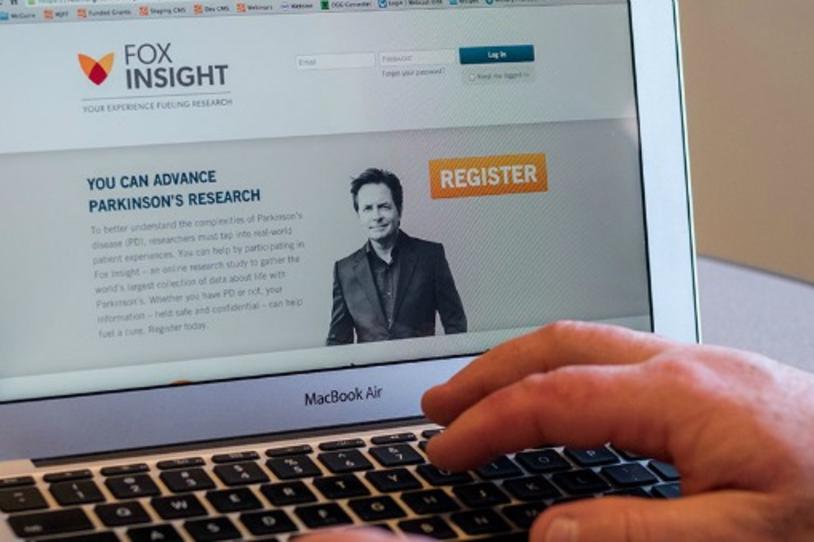
The MJFF-led online study Fox Insight lets users contribute data from their own homes through surveys on the study website.
People with Parkinson’s disease (PD) may live in every corner of the country, but the care specialists trained in PD and the research studies to track disease and develop new treatments are often centralized in major cities. Technology may help overcome geographical and time constraints with “telemedicine” care visits and “teleresearch” studies.
A team led by researchers at the University of Rochester recently published a paper on delivering specialty Parkinson’s care with secure, Web-based videoconferencing. The study, called Connect.Parkinson, asked people to conduct virtual house calls with a PD specialist four times over one year.
They saw great interest with 11,734 individuals visiting the study's website, 927 people completing interest forms, and 210 volunteers from 18 states enrolling in the study from March 2014 to June 2015. The authors wrote, “Remote enrollment in this care model is feasible but is likely affected by differential access to the Internet.”
First author Ray Dorsey, MD, MBA, says, “There is a digital divide with people of older age or with disability less likely to have access to the Internet or new technologies such as smartphones. But that divide is narrowing, and loved ones — children, friends — can be resources to help patients connect with a telemedicine visit or complete a teleresearch online study visit.”
Fox Insight Collects Data through Online Portal and Smartphone Application
Last year, The Michael J. Fox Foundation (MJFF) launched the online study Fox Insight, which asks participants — people with and without PD — to complete virtual study visits by filling out surveys and questionnaires through the www.foxinsight.org website. Patients can also contribute data through a wearable device and Fox Insight smartphone application.
“What we know about Parkinson’s disease is based on observation a few times a year in an artificial setting. We have very limited data on how people with Parkinson’s do on Saturday or Sunday and at 2:00 in the morning,” says Dr. Dorsey. “With smartphones we have more objective, sensitive data and can look at how PD affects activity levels and the impact of exercise, for example.”
Making Smartphone Study Data Available to Researchers Hastens Pace of Discovery
Dr. Dorsey also helped develop mPower, an iPhone Parkinson’s study app built by Sage Bionetworks that collects data on dexterity, balance and gait, memory and voice. Yesterday Sage announced the release to qualified researchers of millions of de-identified mPower data points and a paper in Nature Scientific Data profiling the dataset. Such access for the researcher community could mean greater discovery of trends and nuances that could point to new insights on Parkinson’s disease. Researchers can qualify and access the Parkinson’s database via Synapse, a data and analysis sharing platform.
“Data sharing grows the potential of discovery. More minds and algorithms combing through the data means more insights and trends that we can use to grow our understanding of Parkinson’s disease and to develop new treatments,” says MJFF Senior Vice President of Research Programs Mark Frasier, PhD.
The Foundation is preparing to make the Fox Insight data public, and we have a long history of sharing data from our own studies (such as the Parkinson’s Progression Markers Initiative) and encouraging analysis of available data. MJFF hosted our own Data Challenge in 2013 with publically available smartphone data.
More Parkinson’s Study Apps Join the Field
Another new app study called 100forParkinson’s asks people with PD and their loved ones to track their health data in a smartphone app for 100 days. The study is led by digital health startup uMotif with partners including Parkinson’s UK and The Cure Parkinson’s Trust. Anyone age 18 or older can participate through an Apple or Android smartphone or tablet, and data will be anonymized and used for research to learn more about Parkinson’s disease.
How Do You Choose a Smartphone Study?
With more smartphone and online studies joining the fray, how do you choose between them? Try them out and see which tests or app design you like best. The important thing with these studies is to stick with one you like. Your data becomes more valuable as you contribute over time, so using the app as much as possible (even if it’s not every day) will help researchers observe trends and gain new insights. And, hey, if you have the time and energy, enroll in more than one.
“We want to thank the participants in these studies,” says Dr. Dorsey. “We’re grateful to our patient and volunteer partners in helping us design and improve this new frontier of care and research.”
